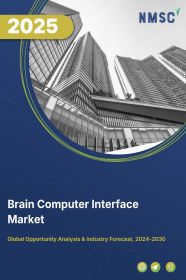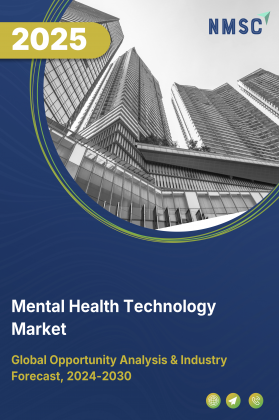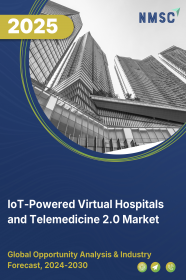
Brain Computer Interface Market by Type (Non-Invasive Brain Computer Interface, Invasive Brain Computer Interface, Partially Invasive Brain Computer Interface, and Others), by Technology (Bit Brain, Brain UP, Brain Gate, Emotive, Electroencephalography, Direct Neural Interface, and Synthetic Telepathy Interface) by Component (Hardware and Software) - Global Opportunity Analysis and Industry Forecast, 2023–2030
Market Definition
The global Brain Computer Interface Market size was valued at USD 1.84 billion in 2022, and is predicted to reach USD 5.99 billion by 2030, with a CAGR of 15.9% from 2023 to 2030.
A brain computer interface (BCI), also called as brain machine interface, is a computer-based system that acquires brain signals. The signals are analyzed by BCI and then translated into commands that are relayed to an output device for carrying out a desired action. Thus, it is an interactive platform or a communication link between a human brain and an external device. BCI is used extensively in the healthcare industry as it can assist people living with disability to acquire relevant skills and knowledge, diagnose and manage depression, communicate, move, and interact socially.
Market Dynamics and Trends
Increasing demand for brain computer interface is due to rising adoption of BCI in the gaming industry as BCI can help gamers translate the brain signals into machine commands. For instance, in January 2021, Valve Corporation, an American video game company, announced the launch of Galea, specifically for the use of VR/AR headsets fitted with electroencephalogram (EEG) devices. Galea also delivers data points that could inform game developers how to create better and more immersive games.
In addition, the growing expansion and collaboration by various companies of brain computer interface boost the market growth. For instance, in June 2021, CorTec GmbH (CorTec) and Blackrock Neurotech, LLC announced that they entered a strategic partnership. They combined Blackrock Neurotech’s industry-leading experience in delivering BCI systems with CorTec’s portfolio of cutting-edge neurodevices to accelerate access to researchers, open new markets, and expand applications in the implantable markets.
However, the high cost of brain-computer interface devices is expected to restrain the growth of the market during the forecast period. On the contrary, innovations to merge artificial intelligence (AI) within the brain computer interface, as AI algorithms such as machine learning and deep learning can aid in improving BCI system’s performance, are expected to create ample growth opportunities for the market in the coming years.
Market Segmentations and Scope of the Study
The brain computer interface market is segmented on the basis of type, technology, component, application, end user, and geography. On the basis of type, the market is categorized into non-invasive brain computer interface, invasive brain computer interface, partially invasive brain computer interface, and others. On the basis of technology, the market is classified into bit brain, brain up, brain gate, emotive, electroencephalography, direct neural interface, and synthetic telepathy interface. On the basis of component, the market is segmented into hardware and software. On the basis of application, the market is divided into communication & control, healthcare, smart home control, entertainment & gaming, and others. On the basis of end user, the market is classified into medicine, military, defense & aerospace, manufacturing, and others. Geographic breakdown and analysis of each of the aforesaid segments includes regions such as North America, Europe, Asia-Pacific, and RoW.
Geographical analysis
North America holds the dominant share of the brain computer interface market at present, and is expected to continue its dominance during the forecast period. The availability of implanted brain computer interface devices for patients with paralysis boosts the market growth of the region.
BCI devices allow individuals with paralysis to control external devices such as prosthetic limbs and computers directly through their thoughts. This technology has a huge potential to improve the quality of life for people with paralysis by giving them more independence and control over their environment.
Moreover, the growing innovations in the region by various organizations for developing robots with the help of BCI technology drives the market growth. For instance, in June 2019, Carnegie Mellon University, in collaboration with the University of Minnesota, made an innovation in the field of non-invasive robotic device control. By using a non-invasive BCI, researchers developed the first-ever mind-controlled robotic arm that has an ability to track the motion and follow the cursor.
On the other hand, Asia-Pacific is expected to show a steady rise in the market, due to growing initiatives by governments of various countries for launching new products of BCI that could collect and analyze signals from human brain. This type of innovation will help in paving the way for next-generation technology in industries such as aerospace and medicine.
For instance, in June 2021, a neuro-engineering team at Tianjin University in China launched brain talker chip, which provides higher system-on-chip integration using lesser power. A brain electrode cap equipped with this brain talker chip allows a person to type by using his own mind and thus characters appear on the screen by interpreting only brain signals without the need for physical typing.
Competitive Landscape
The brain computer interface industry comprises of various market players such as Blackrock Microsystems LLC, Advanced Brain Monitoring, Inc., ClearPoint Neuro, Cadwell Industries, Inc., Cortech Solutions, Inc., Emotiv, Integra Lifesciences, Natus Medical Incorporated, Neurosky, and Openbci.
These market players are adopting various strategies such as joint venture and planning expansion of businesses across various regions to maintain their dominance in the brain computer interface market.
For instances, in July 2021, ClearPoint Neuro made an agreement with Blackrock Neurotech to develop an automated surgical solution that can implant BCIs for patients suffering from a range of different neurological disorders such as paralysis, blindness, hearing loss, and others.
Also, in August 2020, Blackrock Microsystems acquired a worldwide license to from Wyss Center for Bio- and Neuro-engineering to commercialize its neural signal processing and decoding software platform for research and clinical applications.
Key Benefits
-
The report provides the brain computer interface market analysis of the current market and estimations from 2023 to 2030. This analysis assists in identifying the prevailing market opportunities to capitalize on.
-
The study comprises of a comprehensive analysis of the global market trends, including the current and future trends for depicting the prevalent investment pockets in the market.
-
The information related to key drivers, restraints, and opportunities and their impact on the market is provided in the report.
-
The competitive analysis of the market players along with their market share in the brain computer interface market is mentioned.
-
The SWOT analysis and Porter’s Five Forces model are elaborated in the study.
-
The value chain analysis in the market study provides a clear picture of the stakeholders’ roles.
Brain Computer Interface Market Key Segments
By Type
-
Non-Invasive Brain Computer Interface
-
Invasive Brain Computer Interface
-
Partially Invasive Brain Computer Interface
-
Others
By Technology
-
Bit Brain
-
Brain UP
-
Brain Gate
-
Emotive
-
Electroencephalography
-
Direct Neural Interface
-
Synthetic Telepathy Interface
By Component
-
Hardware
-
Software
By Application
-
Communication & Control
-
Healthcare
-
Smart Home Control
-
Entertainment & Gaming
-
Others
By End User
-
Medicine
-
Military
-
Defense & Aerospace
-
Manufacturing
-
Others
By Geography
-
North America
-
The U.S.
-
Canada
-
Mexico
-
-
Europe
-
The U.K.
-
Germany
-
France
-
Italy
-
Spain
-
Rest of Europe
-
-
Asia-Pacific
-
China
-
India
-
Japan
-
South Korea
-
Australia
-
Rest of Asia-Pacific
-
-
RoW
-
UAE
-
Saudi Arabia
-
South Africa
-
Brazil
-
Remaining countries
-
Report Scope and Segmentation
|
Parameters |
Details |
|
Analysis Period |
2022–2030 |
|
Base Year Considered |
2022 |
|
Forecast Period |
2023–2030 |
|
Market Size Estimation |
Billion (USD) |
|
Market Segmentation |
By Categorized (non-invasive brain computer interface, invasive brain computer interface, partially invasive brain computer interface, and others), By Technology (bit brain, brain up, brain gate, emotive, electroencephalography, direct neural interface, and synthetic telepathy interface), By Component (hardware and software), By Application (communication & control, healthcare, smart home control, entertainment & gaming, and others), By End User (medicine, military, defense & aerospace, manufacturing, and others) |
|
Geographical Segmentation |
North America (U.S., Canada, Mexico) Europe (The U.K., Germany, France, Italy, Spain, Rest of Europe), Asia-Pacific (China, India, Japan, South Korea, Australia, Rest of Asia-Pacific), Rest of the World (UAE, Saudi Arabia, South Africa, Brazil, Remaining countries) |
|
Companies Profiled |
Blackrock Microsystems LLC, Advanced Brain Monitoring, Inc., ClearPoint Neuro, Cadwell Industries, Inc., Cortech Solutions, Inc., Emotiv, Integra Lifesciences, Natus Medical Incorporated, Neurosky, and Openbci. |
Key Players
-
Blackrock Microsystems LLC
-
Advanced Brain Monitoring, Inc.
-
ClearPoint Neuro
-
Cadwell Industries, Inc.
-
Cortech Solutions, Inc.
-
Emotiv
-
Integra Lifesciences
-
Natus Medical Incorporated
-
Neurosky
-
Openbci




















 Speak to Our Analyst
Speak to Our Analyst

























